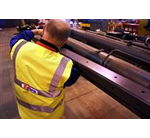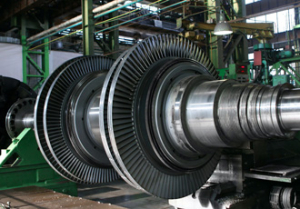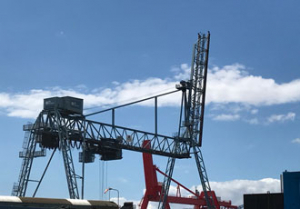Hydraulic Tipping Cylinders Will Last the Life of the Vehicle, if Properly Maintained…. says Peter Smith of Edbro PLC
17th November 2011
Source:
Edbro PLC

Hydraulic tipping cylinders are fundamental components to the safe and reliable operation of rigid trucks and trailers. Properly maintained, they will last the life of the vehicle. Unfortunately, maintenance is all too often overlooked, and cylinders suffer abuse in key areas, which can affect both their safety in operation and also their reliability. The core problem seems to be one of time constraints: pressurised schedules that prevent operators taking vehicles out of service even for a few hours, to perform routine maintenance. One can understand this reticence, with a truck inoperative for a day costing around £400. However, on the other side of the equation, there is the fact that, if a truck is taken out of service for preventative maintenance, then the maintenance is scheduled; the operator is in control and can determine the most opportune time for the work to be performed. The alternative could be a breakdown at much higher cost.
Larger fleet operators appreciate this reasoning and usually have preventative maintenance schedules. Lacking the resources of larger organisations, smaller fleets and owner operators are not generally able to afford tipping cylinders the same levels of attention. As a result, there is more onus on the driver of the vehicle to undertake the simple day-to-day tasks that keep the tipping cylinder in good working order. This is not a problem if the driver is aware of what is required; unfortunately, he often is not. Here the problem is not related to the supplier: Edbro supports every tipping cylinder it supplies with an operating manual. Rather, it is whether the manual finds its way from the body builder into the hands of the truck operator or driver- the people who most require it. Experience shows that this is often not the case, and the result is a situation that has long-term implications for the operating life and safety of the tipping cylinder and; hence, often serious cost implications for the truck operator.
The operator’s manual is crucial because it provides key information that enables the driver to learn the do’s and don’ts of cylinder operation. It also enables him to familiarise himself with and check the key areas of the tipping cylinder system before he puts it to everyday use.
The general areas that require checking include: hoses and fittings, for abrasion and leaks; hoist and hinge mountings for security & wear; oil level; detachable hose couplings for tightness; the PTO engaged warning system; and the body raised warning system.
In addition to familiarisation, the driver must be aware of the safety code for tipping, and how compromising the code affects the operation and life of the tipping cylinder. Prime examples are inordinate loading of the tipping cylinder past its recommended capacity - Edbro designs all of its tipping cylinders with a minimum 50% overload factor of safety to combat this – which in turn helps to resist the effects of tipping on uneven ground, especially with what are known as “sticky loads”.
So-called “sticky loads” are those that refuse to slide from the body once the tipper is raised. In many cases the drivers reaction to this problem is to “shunt” the load: that is to drive the vehicle forward with the body fully raised, and then brake suddenly to provide inertia to release the load. Unfortunately, this process can cause a tipping cylinder to buckle, sometimes with disastrous results, such as piercing the cab of the vehicle.
The second problem for tipping cylinders resulting from sticky loads is that they can adhere to just one side of the trailer body as the body is raised. The result is that the body tips to the load side, moving the centre of gravity outside of the centreline of the vehicle. This, in turn, can cause the vehicle to roll over, and usually destroys the cylinders as a result.
In addition to the state of the load itself, another contributory factor to this problem is the failure to regularly regrease hinge points both on the tipping cylinder and body. Many operators use power wash equipment that blasts under body areas of the trailer, in the process often removing grease from these critical hinge points.
What can result from this is that the hinge points on one side of the body often become looser than those on the opposite side, causing an imbalance, which can contribute to a roll over situation. To avoid this problem, it is essential to regularly grease the brackets that fix the tipping cylinder, and check them for any signs of excess wear. Checking and lubricating these brackets on a regular basis is one of a list of eleven actions recommended by Edbro to ensure regular maintenance of its tipping cylinders. The actions are carried out with the body of the truck fully down and the vehicle parked on level ground with its engine off.
The first nine actions should be performed on a monthly basis:
• Top up the oil in the tipping cylinder tank to dipstick level with clean hydraulic oil. This must be performed with the ram retracted.
• Use a grease gun to lubricate all lifting points on the tipping cylinder and also grease the tail door hinge and locking mechanism.
• Check the ram trunnion arms, the outer cover trunnion arms and the rear hinge brackets for wear and the outer cover for corrosion.
• Where appropriate- check that quick release couplings seal when uncoupled.
• Replace any worn or damaged flexible pipes.
• Make sure all flexible pipes are secured to the chassis and are not hanging loose.
• Tighten any loose pipe connections (not while under pressure)
• Check that the outer cover fixing studs on the tipping cylinder are tight.
• Check that the hoist is not juddering, or the tubes are operating out of sequence when lowering. If either or both of these conditions is occurring then there may be air in the system and it may be necessary to bleed the cylinder.
In addition to the above, on a quarterly basis spanners should be used to check the tightness of the fixing bolts on the tipper valve, the PTO and brackets. Finally, on a yearly basis, or more often if the vehicle is working in dusty or dirty conditions, the hydraulic tank of the tipping cylinder should be drained and refilled with clean hydraulic oil. The system oil should be allowed to cool before this procedure is carried out.
If further maintenance is required, but with the body raised, then the body has to be propped for safety reasons. A prop should always be used for maintenance of this type, even if the tipping cylinder used is one of Edbro’s fully integrated CX15 units, which improves safety by preventing the vehicle body from falling should a hose burst.
Finally and importantly, any malfunction in the operation of tipping cylinders should be reported promptly to the relevant service agent. In Edbro’s case this means one of 60 agents nationwide, the largest network in the industry. In addition, Edbro also devotes a section of its website to technical support, which may be of use to customers experiencing problems and includes pdf versions of all product operator handbooks.
The operator’s manual is crucial because it provides key information that enables the driver to learn the do’s and don’ts of cylinder operation. It also enables him to familiarise himself with and check the key areas of the tipping cylinder system before he puts it to everyday use.
The general areas that require checking include: hoses and fittings, for abrasion and leaks; hoist and hinge mountings for security & wear; oil level; detachable hose couplings for tightness; the PTO engaged warning system; and the body raised warning system.
In addition to familiarisation, the driver must be aware of the safety code for tipping, and how compromising the code affects the operation and life of the tipping cylinder. Prime examples are inordinate loading of the tipping cylinder past its recommended capacity - Edbro designs all of its tipping cylinders with a minimum 50% overload factor of safety to combat this – which in turn helps to resist the effects of tipping on uneven ground, especially with what are known as “sticky loads”.
So-called “sticky loads” are those that refuse to slide from the body once the tipper is raised. In many cases the drivers reaction to this problem is to “shunt” the load: that is to drive the vehicle forward with the body fully raised, and then brake suddenly to provide inertia to release the load. Unfortunately, this process can cause a tipping cylinder to buckle, sometimes with disastrous results, such as piercing the cab of the vehicle.
The second problem for tipping cylinders resulting from sticky loads is that they can adhere to just one side of the trailer body as the body is raised. The result is that the body tips to the load side, moving the centre of gravity outside of the centreline of the vehicle. This, in turn, can cause the vehicle to roll over, and usually destroys the cylinders as a result.
In addition to the state of the load itself, another contributory factor to this problem is the failure to regularly regrease hinge points both on the tipping cylinder and body. Many operators use power wash equipment that blasts under body areas of the trailer, in the process often removing grease from these critical hinge points.
What can result from this is that the hinge points on one side of the body often become looser than those on the opposite side, causing an imbalance, which can contribute to a roll over situation. To avoid this problem, it is essential to regularly grease the brackets that fix the tipping cylinder, and check them for any signs of excess wear. Checking and lubricating these brackets on a regular basis is one of a list of eleven actions recommended by Edbro to ensure regular maintenance of its tipping cylinders. The actions are carried out with the body of the truck fully down and the vehicle parked on level ground with its engine off.
The first nine actions should be performed on a monthly basis:
• Top up the oil in the tipping cylinder tank to dipstick level with clean hydraulic oil. This must be performed with the ram retracted.
• Use a grease gun to lubricate all lifting points on the tipping cylinder and also grease the tail door hinge and locking mechanism.
• Check the ram trunnion arms, the outer cover trunnion arms and the rear hinge brackets for wear and the outer cover for corrosion.
• Where appropriate- check that quick release couplings seal when uncoupled.
• Replace any worn or damaged flexible pipes.
• Make sure all flexible pipes are secured to the chassis and are not hanging loose.
• Tighten any loose pipe connections (not while under pressure)
• Check that the outer cover fixing studs on the tipping cylinder are tight.
• Check that the hoist is not juddering, or the tubes are operating out of sequence when lowering. If either or both of these conditions is occurring then there may be air in the system and it may be necessary to bleed the cylinder.
In addition to the above, on a quarterly basis spanners should be used to check the tightness of the fixing bolts on the tipper valve, the PTO and brackets. Finally, on a yearly basis, or more often if the vehicle is working in dusty or dirty conditions, the hydraulic tank of the tipping cylinder should be drained and refilled with clean hydraulic oil. The system oil should be allowed to cool before this procedure is carried out.
If further maintenance is required, but with the body raised, then the body has to be propped for safety reasons. A prop should always be used for maintenance of this type, even if the tipping cylinder used is one of Edbro’s fully integrated CX15 units, which improves safety by preventing the vehicle body from falling should a hose burst.
Finally and importantly, any malfunction in the operation of tipping cylinders should be reported promptly to the relevant service agent. In Edbro’s case this means one of 60 agents nationwide, the largest network in the industry. In addition, Edbro also devotes a section of its website to technical support, which may be of use to customers experiencing problems and includes pdf versions of all product operator handbooks.
Similar articles
More from Edbro PLC
- The correct tipping gear ensures safety and profitability 11th April 2018
- Tipping gear fitted to first vehicles out the door 8th March 2018
- Truck firm uses cylinders to make its own luck 23rd September 2016
- Risk of accidents during tipping reduced 26th August 2016

-(1)ed.jpg)










Write a comment
No comments